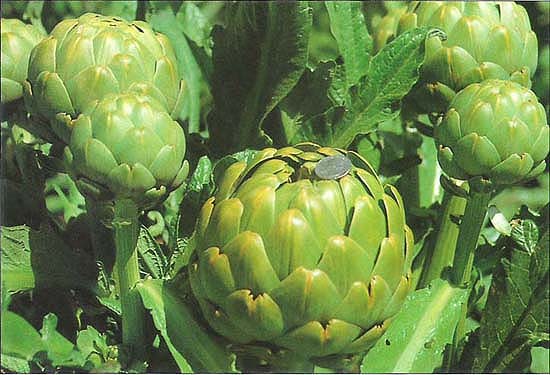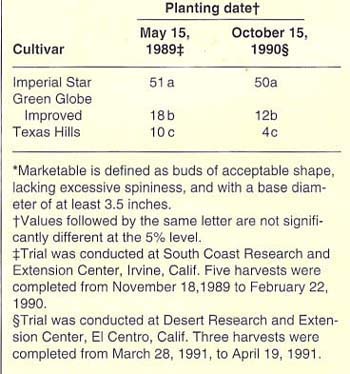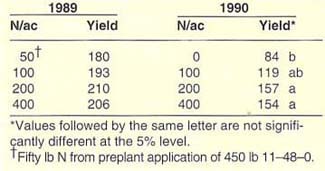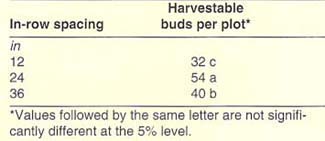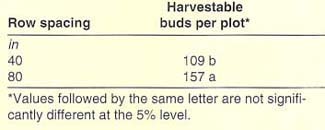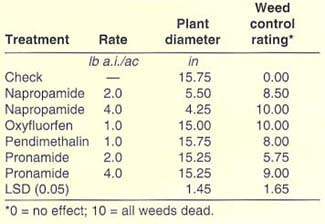All Issues
Paving the way to a better artichoke
Publication Information
California Agriculture 46(4):28-29.
Published July 01, 1992
PDF | Citation | Permissions
Abstract
Significant yield increases were achieved when a seed-propagated, thornless artichoke cultivar was developed for winter production in coastal and desert regions of Southern California and Arizona. The new cultivar was compared to commercial seed-propagated artichoke cultivars. Through research on fertilization, spacing, and weed control, scientists developed guidelines for producing these artichokes as annuals.
Full text
An overmature ‘Imperial Star’ bud (foreground) does not spread its bracts as fully as do other varieties, but the quarter-sized gap between bract tips shows that this artichoke is unmarketable. Background buds are mature and harvestable.
Cool winters in California's central coast limit yields from November to March for ‘Globe’ artichokes that have traditionally been grown as perennials and harvested in two distinct periods. In perennial production, plants are cut back to slightly below ground level between mid-April and mid-June for fall and spring production, or in late August or September for spring and summer harvests.
In contrast, the annual production methods and seeded artichoke varieties employed in Southern California take advantage of a warnter winter climate and favorable winter market prices. In Orange and San Diego counties, seeds are planted in May or June to produce transplants. Starts are transplanted into the field in July or August, and harvest runs from October to March.
Still another method is used for artichoke production in California and Arizona desert regions, where growers direct-seed fields in August or September for production from February to April. They occasionally use transplants to obtain earlier production.
Production of artichokes from seed for winter harvest has been limited by a high percentage of unmarketable (off-type, spiny, or small) buds associated with commercially available seeded artichoke cultivars. Furthermore, research-based information on basic production techniques for seed-propagated artichoke production in Southern California has been unavailable. We conducted a breeding program and cultural research trials that developed an improved seeded artichoke cultivar and valuable production information.
Research trials
The breeding program and research trials on fertility, plant spacing, and weed control were conducted at the University of California's Desert and South Coast research and extension centers in El Centra and Irvine. Except where noted, research trials utilized the ‘Imperial Star’ cultivar in plots 40 feet long with rows 80 inches apart; plants were spaced 2 feet apart in the row. Seed was planted in transplant trays in mid-May at Irvine for variety, fertility, spacing, and weed-control trials. Transplants were transferred to drip-irrigated fields in early July, approximately 6 weeks after initial seeding.
Tensiometers placed 6, 12, and 18 inches deep in plant rows were used to schedule irrigations and monitor leaching in the drip-irrigated trials. Except for the fertility research, drip-irrigated trials received nitrogen (N) at a rate of 10 pounds per acre (lb/ac), applied through drip lines once a week as ammonium nitrate liquid fertilizer. All trials at Irvine were conducted on sandy loam soils.
Breeding, selection, and variety trials conducted at El Centro were direct-seeded on alternate 40-inch beds, sprinkler-irrigated through emergence, and furrow-irrigated for the remainder of the season. Beds were broken and furrows changed to 80-inch spacing when plants were 12 inches in diameter. Five hundred pounds of 11-52-0 preplant fertilizer, equivalent to 55 pounds of nitrogen and 260 pounds of phosphoric acid (P2O5) per acre, were broadcast before listing and sidedress applications of ammonium nitrate at 60 lb/ac N were applied three times during the season. Thinning was accomplished at the fourth true leaf stage. All trials at El Centro were also conducted on sandy loam soils.
Development and evaluation
A new artichoke cultivar, ‘Imperial Star,’ was developed by means of crosses and selection to overcome poor uniformity in bud size and shape. ‘Imperial Star’ is a thornless globe artichoke cultivar with distinctive bract glossiness. With increasing maturity, the bracts are slow to spread open. Primary buds averaged 4.3 inches in diameter in the trials. ‘Imperial Star’ shows broad climatic adaptability and has done well in coastal and desert production areas of Southern California and in Arizona.
‘Imperial Star’ was compared with ‘Green Globe Improve’ (Sunseeds Genetics, Inc.) and ‘Texas Hills’ (D. Palmer Seed Company) cultivars in replicated trials evaluating marketable yield during 1989 and 1990. Marketable size in variety comparison trials was defined as buds with base diameters of at least 3.5 inches, corresponding to the minimum market size for artichokes packed 36 per carton. Misshapen buds that are only used for processing and excessively spiny buds were also excluded. Artichokes with small spines are marketable and were counted, but the market trend is toward thornless buds.
The fresh market prefers buds 24 and 36 per carton (4.5 to 4.0 and 4.0 to 3.5 inches in diameter, respectively). Seed-propagated artichokes have gained an unfortunate reputation for smaller overall bud size, with the majority of buds harvested in the 48-per-carton size range (3.5 to 3.0 inches in diameter). To prevent inflating harvested bud numbers with large percentages of 48-size fruit, only large buds (18,24, and 36 buds per carton) were judged marketable in our variety comparison trials. The decision to limit marketable size to the three largest size classifications was supported by the poor acceptance of smaller buds in the fresh market and the lack of facilities for canning artichoke hearts in Southern California.
In the variety comparison trials, ‘Imperial Star’ showed uniformity of maturity, bud type, size, and earliness, which lead to significantly higher marketable yields during winter production (table 1). ‘Imperial Star’ has received variety certification and is protected under the U.S. Plant Variety Protection Act.
Fertility research
Effects of four nitrogen application rates on the yield of buds greater than 3 inches in diameter were evaluated in replicated research trials at Irvine in 1989 and 1990. The 1989 fertility trial followed a year of fallow and a barley crop that was cut and removed from the trial area to reduce the field's residual nitrogen fertility level. Plots 60 feet long received 450 pounds of monoammonium phosphate (11-48-0) in 1989 and triple super phosphate (0-46-0) in 1990 as preplant banded applications. Nitrogen treatments were made with ammonium nitrate applied weekly through the drip irrigation lines. Nitrogen was applied at the rates of 100, 200, and 400 lb/ac both years; 200 lb/ac gave the highest numerical yield both years (table 2).
Plant spacing
A plant-spacing trial conducted in San Diego County during 1989 on 30-foot-long plots compared 12-, 24-, and 36-inch in-row plant spacings on 72-inch drip-irrigated beds. Counts of harvestable buds with diameters greater than 3 inches showed that an in-row spacing of 24 inches was preferable to other spacings tested (table 3). Plants spaced at 12 inches increased in lodging because of excessive competition, which led to spindly stem growth.
TABLE 1. Number of marketable* buds per plot for seeded artichoke cultivars grown in California, 1989 and 1990
TABLE 2. Nitrogen rate effects on number of artichoke buds per plot for seeded artichoke grown at South Coast Research and Extension Center, Irvine
TABLE 3. Effects of in-row spacing on counts of artichoke buds larger than 3 inches in diameter per plot in 1989
TABLE 4. Effects of between-row spacing on yield of artichoke buds larger than 2.75 inches in diameter per plot in 1990
TABLE 5. Effects of preemergence herbicide treatments on transplanted artichoke growth and weed control
A 1990 spacing trial at Irvine utilized 24-inch in-row spacing and compared 40-and 80-inch between-row spacings. It was hoped that competition would restrict overall plant size while allowing increased plant populations and yields. Buds greater than 2.75 inches in diameter were counted in this trial to compare the total bud number in all size classes from 18 to 60 buds per carton. Bud number was expected to be higher in the closer row spacing with smaller bud sizes predominating. Eighty-inch between-row spacing, however, gave higher numbers of harvested buds (table 4) and was also preferred because of easier harvesting and easier equipment entry into the field.
Weed control
A trial on sandy loam soil at Irvine in 1989 evaluated the effectiveness of pre-emergence herbicide treatments on transplanted artichokes. The herbicides tested had appeared to be effective when used in a perennial culture, but they had not been tested nor are they registered for use in an annual production scheme. Treatments consisted of pronamide (Kerb) at 2 and 4 lb a.i./ac, pendimethalin (Prowl) at 1 lb a.i./ac, napropamide (Devrinol) at 2 and 4 lb a.i./ac, and oxyfluorfen (Goal) at 1 lb a.i./ac. Only napropamide caused phyto-toxic effects, resulting in severe stunting and some stand loss.
Ratings taken 4 weeks after transplanting and 6 weeks after initial pre-emer-gence treatments showed that overall weed control was best for high-rate napropamide and oxyfluorfen applications with good weed control results for the 4-lb pronamide application and the pendimethalin application (table 5). Only the low-rate pronamide and pendimethalin treatments differed significantly from other treatments in their degree of weed control.
Conclusions
The significant yield improvement in annual artichoke production associated with the new cultivar ‘Imperial Star’ suggests that continued improvements can be made in breeding. Fertility trials indicate that nitrogen applications between 100 and 200 lb/ac are capable of optimizing yields. Plant spacing research determined that between-row spacings from 72 to 80 inches and an in-row spacing of 24 inches provide high yields with ease of harvesting and field access for equipment. Pre-emergence herbicides could be valuable in reducing weed competition without affecting artichoke transplant growth.



